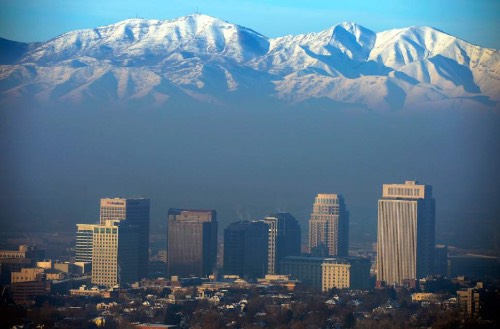Air Quality
Despite significant advances in improving air quality, human society continues to face challenges arising from cross-border transport of pollutants, wildfire emissions, increased exposure by expanding urban populations, and mounting medical evidence pointing to adverse health effects due to exposure to various pollutants. Knowledge of atmospheric science is critical for devising effective policy in order to improve air quality, mitigate exposure, and predict the impacts of climate change on future air quality.
The Lead Researchers and Their Work

Professor John Linseeks to understand how emissions from cities, wildfires, and dust events affect the air quality at a particular “receptor” location. He is a founding member of the Utah Atmospheric Trace Gas & Air Quality lab (“U-ATAQ”) and combines atmospheric models with observations from a variety of platforms (surface networks, light rail, mobile lab, satellites) to address questions related to air quality. He is also interested in understanding how emissions of air quality-relevant pollutants are linked with emissions of greenhouse gases such as carbon dioxide and methane, in order to devise means of improving air quality while mitigating climate change.
 Professor John Horel is leading research on the role of atmospheric vertical structure and transport upon
pollutant concentrations along the Wasatch Front and in the Uintah Basin. High concentrations
of particulates during winter and ozone during summer along the Wasatch Front and
ozone during winter in the Uintah Basin have serious health consequences for the residents
of those areas. Data collected from hands-on field campaigns combined with high-resolution
modeling of terrain-flow interactions are analyzed to help understand atmospheric
controls on pollutant concentrations.
Professor John Horel is leading research on the role of atmospheric vertical structure and transport upon
pollutant concentrations along the Wasatch Front and in the Uintah Basin. High concentrations
of particulates during winter and ozone during summer along the Wasatch Front and
ozone during winter in the Uintah Basin have serious health consequences for the residents
of those areas. Data collected from hands-on field campaigns combined with high-resolution
modeling of terrain-flow interactions are analyzed to help understand atmospheric
controls on pollutant concentrations.

Research Assistant Professor Sebastian Hoch uses in-situ and remote sensing instrumentation to monitor the evolution of persistent wintertime cold air pools (PCAPs) in the Salt Lake Valley. He has collaborated with local and external researchers to investigate the complex interaction between air chemistry and meteorological processes during wintertime particulate pollution events.
